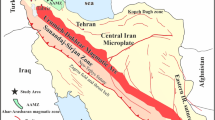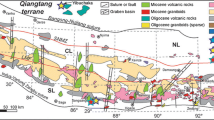Abstract
Twelve whole-rock samples of volcanic rocks and a composite of 11 basanitoid samples from Ross Island and vicinity, Antarctica show a narrow range of 87Sr/86Sr ratios from 0.70305 to 0.70339. This range is consistent with a model of differentiation from a single parent magma, but the data allow a 30% variation in the 87Rb/86Sr ratio in the source region if the average ratio is less than 0.057 and if the source region has existed as a closed system for 1.5 b.y. Megacrysts of titaniferous augite, kaersutite, and anorthoclase are isotopically indistinguishable from the host volcanic rocks and therefore are probably cogenetic with the volcanic sequence. A single trachyte sample is isotopically distinct from the rest of the volcanic rocks and probably was contaminated with crustal strontium.
Ultramafic and mafic nodules found in association with basanitoids and trachybasalts have 87Sr/86Sr ratios ranging from 0.70275 to 0.70575. Several of these nodules exhibit evidence of reaction with the melt and are isotopically indistinguishable from their hosts, but data for seven granulite-facies nodules show an apparent isochronal relationship. Although this isochron may be fortuitous, the resulting age of 158±22 m.y. is similar to ages reported for the voluminous Ferrar Dolerites, and suggests isotopic re-equilibration within the lower crust and upper mantle. These nodules are not genetically related to the Ferrar Dolerites, as evidenced by their lower initial 87Sr/86Sr ratios.
Three ultramafic nodules are texturally and isotopically distinct from the rest of the analyzed nodules. These are friable, have larger 87Sr/86Sr ratios, and may represent a deeper sampling of mantle rock than the granulite-facies nodules. They were, however, derived at a shallower depth than the alkalic magma. Thus they are not genetically related to either the magma or the granulite-facies nodules.
Similar content being viewed by others
References
Beeson, M.H., Jackson, E.D.: Origin of the garnet pyroxenite xenoliths at Salt Crater, Oahu. Mineralog. Soc. Am. Spec. Papers 3, 95–112 (1970)
Binns, R.A., Duggan, M.B., Wilkinson, J.F.G.: High pressure megacrysts in alkaline lavas from northeastern New South Wales. Am. J. Sci. 269, 132–168 (1970)
Carmichael, I.S.E., McDonald, A.: The geochemistry of some natural acid glasses from the North Atlantic Tertiary province. Geochim. Cosmochim. Acta 25, 189–222 (1961)
Compston, W., McDougall, I., Heier, K.S.: Geochemical comparison of the Mesozoic basaltic rocks of Antarctica, South Africa, South America and Tasmania. Geochim. Cosmochim. Acta 32, 129–149 (1968)
Dasch, E.J., Green, D.H.: Strontium isotope geochemistry of lherzolite inclusions and host basaltic rocks, Victoria, Australia. Am. J. Sci. 257, 461–469 (1975)
Forbes, R.B., Kuno, H.: The regional petrology of peridotite inclusions and basaltic host rocks. In: Upper Mantle Symposium, New Delhi, 1964, Internat. Union. Geol. Sci., pp. 161–179. Copenhagen: Berlingske Bogtrykkeri 1965
Forbes, R.B., Ragan, D.M.: Mafic and ultramafic inclusions from the basalts of the Hut Point Peninsula, Ross Island, Antarctica. Bull. Geol. Soc. Am. (in press)
Francis, D.M., Dickey, J.S., Jr.: Poikilitic pyroxene-amphibole xenoliths: cumulate or replacement phenomena from the upper mantle. Geol. Soc. Am. Abs. with programs 7, p. 1078 (1975)
Frey, F.A., Green, D.H.: The mineralogy, geochemistry, and origin of lherzolite inclusions in Victoria basanites. Geochim. Cosmochim. Acta 38, 1023–1059 (1974)
Goldich, S.S., Treves, S.B., Suhr, N.H., Stuckless, J.S.: Geochemistry of the Cenozoic volcanic rocks of Ross Island and vicinity, Antarctica. J. Geol. 83, 415–435 (1975)
Gunn, B. Warren, G.: Geology of Victoria Land between Mawson and Mullock Glaciers, Antarctica. New Zealand Geol. Survey Bull. 71, 157 p. (1962)
Hamilton, W.: The Hallett volcanic province, Antarctica. U.S. Geol. Surv. Profess. Papers 456-C, 62 p. (1972)
Hart, S.R., Brooks, C.: Clinopyroxene-matrix partitioning of K, Rb, Cs, Sr, and Ba. Geochim. Cosmochim. Acta 38, 1797–1806 (1974)
Irving, A.J.: Megacrysts from the Newer Basalts and other basaltic rocks of southeastern Australia. Bull. Geol. Soc. Am. 85, 1503–1514 (1974)
Laughlin, A.W., Brookins, D.G., Causey, J.D.: Late Cenozoic basalts from the Bandera lava field, Valencia County, New Mexico. Bull. Geol. Soc. Am. 83, 1543–1552 (1972)
Laughlin, A.W., Brookins, D.G., Kudo, A.M., Causey, J.D.: Chemical and strontium isotopic investigations of ultramafic inclusions and basalt, Bandera Crater, New Mexico. Geochim. Cosmochim. Acta 35, 107–113 (1971)
LeMasurier, W.E., Wade, F.A.: Volcanic history in Marie Byrd Land: implications with regard to southern hemisphere tectonic reconstructions. Internat. Symp. Andean and Antarctic Volcanological Problems (in press)
Lovering, J.F., Tatsumoto, M.: Lead isotopes and the origin of granulite and eclogite inclusions in deep-seated pipes. Earth Planet. Sci. Lett. 4, 350–356 (1968)
McDougall, I.: Potassium-argon measurements on dolerites from Antarctica and South Africa. J. Geophys. Res. 68, 1535–1545 (1963)
Mudrey, M.G., Jr., McGinnis, L.D.: Antarctica geologic history investigated by diamond drilling. Geology 2, p. 291–924 (1974)
O'Neill, J.R., Hedge, C.E., Jackson, E.D.: Isotopic investigations of xenoliths and host basalts from the Honolulu volcanic series. Earth Planet. Sci. Lett. 8, 253–257 (1970)
Paul, D.K.: Strontium isotope studies on ultramafic inclusions from Dreiser Weiher, Eifel, Germany. Contr. Mineral. Petrol. 34, 22–28 (1971)
Peterman, Z.E., Carmichael, I.S.E., Smith, A.L.: Strontium isotopes in Quaternary basalts of southeastern California. Earth Planet. Sci. Lett. 7, 381–384 (1970)
Peterman, Z.E., Hedge, C.E.: Related strontium isotopic and chemical variations in oceanic basalts. Bull. Geol. Soc. Am. 82, 493–500 (1971)
Philpotts, J.A., Schnetzler, C.C.: Phenocryst-matrix partition coefficients for K, Rb, Sr, and Ba, with applications to anorthosite and basalt genesis. Geochim. Cosmochim. Acta 34, 307–322 (1970)
Roe, G.D.: Rubidium-strontium analyses of ultramafic rocks and the origin of peridotites. In: Twelfth Annual Progress Report for 1964, pp. 159–190. Cambridge, Mass.: M.I.T. Dept. Geology and Geophysics 1964
Shimizu, N.: An experimental study of the partitioning of K, Rb, Cs, Sr, and Ba between clinopyroxene and liquid at high pressure. Geochim. Cosmochim. Acta 38, 1789–1796 (1974)
Smith, W.C.: The volcanic rocks of the Ross Archipelago, British Antarctic (Terra Nova) Expedition, 1910: Nat. Hist. Rep., Geol. 2, 1–107 (1954)
Smithson, S.S.: Gravity interpretation in the Transantarctic Montains near McMurdo Sound, Antarctica. Bull. Geol. Soc. Am. 83, p. 3437–3442 (1972)
Stuckless, J.S., Irving, A.J.: Strontium isotope geochemistry of megacrysts and host basalts from southeastern Australia. Geochim. Cosmochim. Acta 40, p. 109–113 (1976)
Stueber, A.M., Ikramuddin, M.: Rubidium, strontium and the isotopic composition of strontium in ultramafic nodule minerals and host basalts. Geochim. Cosmochim. Acta 38, 207–216 (1974)
Sun, S.S., Hanson, G.N.: Origin of Ross Island basanitoids and limitation upon the heterogeneity of mantle sources for alkali basalts and nephelinites. Contrib. Mineral. Petrol. 52, 77–106 (1975)
Sun, S.S., Hanson, G.N.: Rare earth element evidence for differentiation of McMurdo volcanics, Ross Island, Antarctica. Contrib. Mineral. Petrol. 54, 139–155 (1976)
Thompson, J.A.: Report on the inclusions of the volcanic rocks of the Ross Archipelago. Brit. Antarctic Expedit, 1907–1909, Rept., Geol. 2, 129–148 (1916)
York, D.: Least-squares fitting of a straight line with correlated errors. Earth Planet. Sci. Lett. 5, 320–324 (1969)
Author information
Authors and Affiliations
Rights and permissions
About this article
Cite this article
Stuckless, J.S., Ericksen, R.L. Strontium isotopic geochemistry of the volcanic rocks and associated megacrysts and inclusions from Ross Island and vicinity, Antarctica. Contr. Mineral. and Petrol. 58, 111–126 (1976). https://doi.org/10.1007/BF00382180
Received:
Accepted:
Issue Date:
DOI: https://doi.org/10.1007/BF00382180




